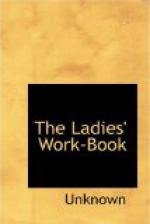1st row: X eight close double stitches, miss the space of six, X repeat, without drawing the thread very tightly across the missing space.
2nd: X five double over the eight, two double on the loop of thread, X repeat.
3rd: X two double on the five, five over the two, X when five stitches are worked over two, one goes between the two, and two on each side of it.
4th: X eight double over five and miss the space over the two, leaving the loop rather loose, X. Repeat from the second row throughout the space.
OPEN DIAMOND (No. 31). 1st row: Five close Brussels, miss the space of two, X eight close, miss the space of two, X to the end of the row.
2nd: Two close, X miss two, two on the loop, miss two, work along the line after all the remainder of the eight, do two on the loop, and on six of the next eight (thirteen altogether), repeat to the end.
3rd: X miss two, two on the loop, miss two, do two on the loop, miss two, do one on every one of the line of stitches but the last two, X repeat.
4th: Two on the loop, miss two, two on the loop, X miss two, two on the loop, one on every stitch, and two on the next loop (thirteen altogether), miss two, two on a loop, X repeat. The next diamond of holes must be so managed as to fall immediately between two of the first row. By repeating the first line, the place will be indicated. In all these stitches, it is assumed that squares are to be filled in. Where the shape varies from that, extra stitches must be added, at the beginning, or taken away, as the case may be, the worker referring to the engraving for the appearance intended to be produced.
CLOSE DIAMOND (No. 32). The first row is plain button-hole stitch.
2nd row: Five stitches, X leave the space of two, fourteen stitches, X repeat.
3rd: Two stitches, X miss two, do two on the loop, miss two, work on all the rest of the fourteen, except the last two, X repeat. In the fourth row, the holes fall over those of the first. The fifth row is all in close stitches. In the sixth, begin to make fresh lines of diamonds, coming exactly between the last set.
ANTWERP LACE (No. 33). 1st row: X eight close, miss the space of two, X repeat.
2nd: X five close over eight close, and two close on the loop, X.
3rd: X two close over five, and five over two, X.
4th: X five close over two, and two over five, X.
5th: X eight close over every five, X repeat.
The above are the principal stitches found in Old Point Lace.
* * * * *
DEEP POINT LACE EDGING.
MATERIALS.—Brooks’ Great Exhibition
Prize Goat’s-head Mecklenburgh
Threads, No. 1, 7, 100, and 120.
Draw the pattern from the engraving, a section of it being given the full size. The paper must then be lined with alpaca. Should a short piece only be required, the pattern should at once be made of the full length; if not, several may be drawn. From the closeness of the work it is impossible to work twice over the same paper.




